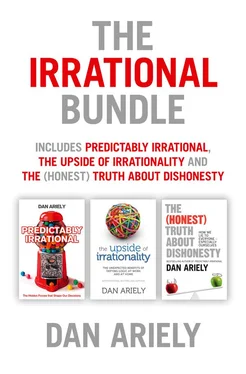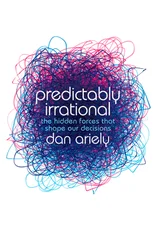Dan Ariely - The Irrational Bundle
Здесь есть возможность читать онлайн «Dan Ariely - The Irrational Bundle» — ознакомительный отрывок электронной книги совершенно бесплатно, а после прочтения отрывка купить полную версию. В некоторых случаях можно слушать аудио, скачать через торрент в формате fb2 и присутствует краткое содержание. Жанр: unrecognised, на английском языке. Описание произведения, (предисловие) а так же отзывы посетителей доступны на портале библиотеки ЛибКат.
- Название:The Irrational Bundle
- Автор:
- Жанр:
- Год:неизвестен
- ISBN:нет данных
- Рейтинг книги:3 / 5. Голосов: 1
-
Избранное:Добавить в избранное
- Отзывы:
-
Ваша оценка:
- 60
- 1
- 2
- 3
- 4
- 5
The Irrational Bundle: краткое содержание, описание и аннотация
Предлагаем к чтению аннотацию, описание, краткое содержание или предисловие (зависит от того, что написал сам автор книги «The Irrational Bundle»). Если вы не нашли необходимую информацию о книге — напишите в комментариях, мы постараемся отыскать её.
The Irrational Bundle — читать онлайн ознакомительный отрывок
Ниже представлен текст книги, разбитый по страницам. Система сохранения места последней прочитанной страницы, позволяет с удобством читать онлайн бесплатно книгу «The Irrational Bundle», без необходимости каждый раз заново искать на чём Вы остановились. Поставьте закладку, и сможете в любой момент перейти на страницу, на которой закончили чтение.
Интервал:
Закладка:
The second world, the one governed by market norms, is very different. There’s nothing warm and fuzzy about it. The exchanges are sharp-edged: wages, prices, rents, interest, and costs-and-benefits. Such market relationships are not necessarily evil or mean—in fact, they also include self-reliance, inventiveness, and individualism—but they do imply comparable benefits and prompt payments. When you are in the domain of market norms, you get what you pay for—that’s just the way it is.
When we keep social norms and market norms on their separate paths, life hums along pretty well. Take sex, for instance. We may have it free in the social context, where it is, we hope, warm and emotionally nourishing. But there’s also market sex, sex that is on demand and that costs money. This seems pretty straightforward. We don’t have husbands (or wives) coming home asking for a $50 trick; nor do we have prostitutes hoping for everlasting love.
When social and market norms collide, trouble sets in. Take sex again. A guy takes a girl out for dinner and a movie, and he pays the bills. They go out again, and he pays the bills once more. They go out a third time, and he’s still springing for the meal and the entertainment. At this point, he’s hoping for at least a passionate kiss at the front door. His wallet is getting perilously thin, but worse is what’s going on in his head: he’s having trouble reconciling the social norm (courtship) with the market norm (money for sex). On the fourth date he casually mentions how much this romance is costing him. Now he’s crossed the line. Violation! She calls him a beast and storms off. He should have known that one can’t mix social and market norms—especially in this case—without implying that the lady is a tramp. He should also have remembered the immortal words of Woody Allen: “The most expensive sex is free sex.”
A FEW YEARS ago, James Heyman (a professor at the University of St. Thomas) and I decided to explore the effects of social and market norms. Simulating the Thanksgiving incident would have been wonderful, but considering the damage we might have done to our participants’ family relationships, we chose something more mundane. In fact, it was one of the most boring tasks we could find (there is a tradition in social science of using very boring tasks).
In this experiment, a circle was presented on the left side of a computer screen and a box was presented on the right. The task was to drag the circle, using the computer mouse, onto the square. Once the circle was successfully dragged to the square, it disappeared from the screen and a new circle appeared at the starting point. We asked the participants to drag as many circles as they could, and we measured how many circles they dragged within five minutes. This was our measure of their labor output—the effort that they would put into this task.
How could this setup shed light on social and market exchanges? Some of the participants received five dollars for participating in the short experiment. They were given the money as they walked into the lab; and they were told that at the end of the five minutes, the computer would alert them that the task was done, at which point they were to leave the lab. Because we paid them for their efforts, we expected them to apply market norms to this situation and act accordingly.
Participants in a second group were presented with the same basic instructions and task; but for them the reward was much lower (50 cents in one experiment and 10 cents in the other). Again we expected the participants to apply market norms to this situation and act accordingly.
Finally, we had a third group, to whom we introduced the tasks as a social request. We didn’t offer the participants in this group anything concrete in return for their effort; nor did we mention money. It was merely a favor that we asked of them. We expected these participants to apply social norms to the situation and act accordingly.
How hard did the different groups work? In line with the ethos of market norms, those who received five dollars dragged on average 159 circles, and those who received 50 cents dragged on average 101 circles. As expected, more money caused our participants to be more motivated and work harder (by about 50 percent).
What about the condition with no money? Did these participants work less than the ones who got the low monetary payment—or, in the absence of money, did they apply social norms to the situation and work harder? The results showed that on average they dragged 168 circles, much more than those who were paid 50 cents, and just slightly more than those who were paid five dollars. In other words, our participants worked harder under the nonmonetary social norms than for the almighty buck (OK, 50 cents).
Perhaps we should have anticipated this. There are many examples to show that people will work more for a cause than for cash. A few years ago, for instance, the AARP asked some lawyers if they would offer less expensive services to needy retirees, at something like $30 an hour. The lawyers said no. Then the program manager from AARP had a brilliant idea: he asked the lawyers if they would offer free services to needy retirees. Overwhelmingly, the lawyers said yes.
What was going on here? How could zero dollars be more attractive than $30? When money was mentioned, the lawyers used market norms and found the offer lacking, relative to their market salary. When no money was mentioned they used social norms and were willing to volunteer their time. Why didn’t they just accept the $30, thinking of themselves as volunteers who received $30? Because once market norms enter our considerations, the social norms depart.
A similar lesson was learned by Nachum Sicherman, an economics professor at Columbia, who was taking martial arts lessons in Japan. The sensei (the master teacher) was not charging the group for the training. The students, feeling that this was unfair, approached the master one day and suggested that they pay him for his time and effort. Setting down his bamboo shinai, the master calmly replied that if he charged them, they would not be able to afford him.
IN THE PREVIOUS experiment, then, those who got paid 50 cents didn’t say to themselves, “Good for me; I get to do this favor for these researchers, and I am getting some money out of this,” and continue to work harder than those who were paid nothing. Instead they switched themselves over to the market norms, decided that 50 cents wasn’t much, and worked halfheartedly. In other words, when the market norms entered the lab, the social norms were pushed out.
But what would happen if we replaced the payments with a gift? Surely your mother-in-law would accept a good bottle of wine at dinner. Or how about a housewarming present (such as an eco-friendly plant) for a friend? Are gifts methods of exchange that keep us within the social exchange norms? Would participants receiving such gifts switch out of the social norms and into market norms, or would offering gifts as rewards maintain the participants in the social world?
To find out just where gifts fall on the line between social and market norms, James and I decided on a new experiment. This time, we didn’t offer our participants money for dragging circles across a computer screen; we offered them gifts instead. We replaced the 50-cent reward with a Snickers bar (worth about 50 cents), and the five-dollar incentive with a box of Godiva chocolates (worth about five dollars).
The participants came to the lab, got their reward, worked as much as they liked, and left. Then we looked at the results. As it turned out, all three experimental groups worked about equally hard during the task, regardless of whether they got a small Snickers bar (these participants dragged on average 162 circles), the Godiva chocolates (these participants dragged on average 169 circles), or nothing at all (these participants dragged on average 168 circles). The conclusion: no one is offended by a small gift, because even small gifts keep us in the social exchange world and away from market norms.
Читать дальшеИнтервал:
Закладка:
Похожие книги на «The Irrational Bundle»
Представляем Вашему вниманию похожие книги на «The Irrational Bundle» списком для выбора. Мы отобрали схожую по названию и смыслу литературу в надежде предоставить читателям больше вариантов отыскать новые, интересные, ещё непрочитанные произведения.
Обсуждение, отзывы о книге «The Irrational Bundle» и просто собственные мнения читателей. Оставьте ваши комментарии, напишите, что Вы думаете о произведении, его смысле или главных героях. Укажите что конкретно понравилось, а что нет, и почему Вы так считаете.












